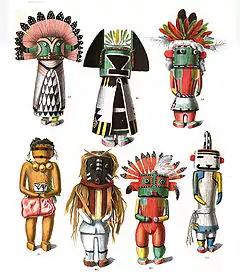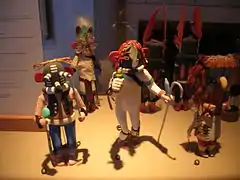Качина
Качина,на языке хопи — kachina, kəˈtʃiːnə, katsina, qacína, /kətˈsiːnə/, множ. ч. katsinim /kətˈsiːnɨm/ — духи в космологии и религии первоначально западных пуэбло,[1] затем прочих народов пуэбло и даже соседних народов, включая давних соперников пуэбло — навахо. Индейцы-пуэбло изготавливают куклы-качина, которые ранее играли церемониальную роль, а в настоящее время являются одним из предметов сувенирной торговли.

Рисунок, изображающий кукол-качина, из книги 1894 г. по антропологии.

Крупную коллекцию кукол-качина собрал известный американский политик Барри Голдуотер. В настоящее время данная коллекция хранится в музее Хёрда.
Примечания
- Walter, Mariko N.; Eva Jane Neumann Fridman. Shamanism: An Encyclopedia of World Beliefs, Practices and Culture (англ.). — ABC-CLIO, 2004. — P. 347—348. — ISBN 1576076458.
Литература
- Anderson, Frank G. (1955). The Pueblo kachina cult: A historical reconstruction. Southwestern Journal of Anthropology, 11, 404—419.
- Anderson, Frank G. (1956). Early documentary material on the Pueblo kachina cult. Anthropological Quarterly, 29, 31-44.
- Anderson, Frank G. (1960). Inter-tribal relations in the Pueblo kachina cult. In Fifth International Congress of Anthropological and Ethnological Sciences, selected papers (pp. 377-383).
- Dockstader, Frederick J. «The Kachina & The White Man: A Study of The Influence of White Culture on The Hopi Kachina Cult.» Bloomfield Hills, Michigan: Cranbook Institute of Science, 1954.
- Dozier, Edward P. (1970). The Pueblo Indians of North America. Holt, Rinehart, and Winston.
- Glenn, Edna "Kachinas, « in Hopi Nation: Essays on Indigenous Art, Culture, History, and Law, 2008.
- Kennard, Edward A. & Edwin Earle. „Hopi Kachinas.“ New York: Museum of The American Indian, Hye Foundation, 1971.
- Schaafsma, Polly. (1972). Rock art in New Mexico. Santa Fe: State Planning Office..
- Schaafsma, Polly (Ed.). (1994). Kachinas in the pueblo world. Albuquerque, NM: University of New Mexico Press.
- Schaafsma, Polly; & Schaafsma, Curtis F. (1974). Evidence for the origins of the Pueblo katchina cult as suggested by Southwestern rock art. American Antiquity, 39 (4), 535—545.
- Schlegel, Alice, »Hopi Social Structure as Related to Tihu Symbolism, « in Hopi Nation: Essays on Indigenous Art, Culture, History, and Law, 2008.
- Sekaquaptewa, Helen. „Me & Mine: The Life Story of Helen Sekaquaptewa.“ Tucson, Arizona: University of Arizona Press, 1969.
- Stephen, Alexander M. „Hopi Journal.“ New York: Columbia University Press, 1936.
- Stewart, Tyrone. Dockstader, Frederick. Wright, Barton. „The Year of The Hopi: Paintings & Photographs by Joseph Mora, 1904-06.“ New York, Rizzoli International Publications, 1979.
- Talayesua, Don C. „Sun Chief: The Autobiography of a Hopi Indian.“ New Haven, Connecticut: Institute of Human Relations/Yale University Press, 1942.
- Titiev, Mischa. „Old Oraibi: A Study of The Hopi Indians of the Third Mesa.“ Cambridge, Massachusetts: Peabody Museum, 1944.
- Waters, Frank. „Masked Gods: Navajo & Pueblo Ceremonialism.“ Denver, Colorado: Sage Books, 1950.
- Waters, Frank. „The Book of The Hopi.“ New York, Viking Press, 1963.
- Wright, Barton. „Hopi Kachinas: The Complete Guide to Collecting Kachina Dolls.“ Flagstaff, Arizona: Northland Press, 1977.
- Wright, Barton, »Hopi Kachinas: A Life Force, " in Hopi Nation: Essays on Indigenous Art, Culture, History, and Law, 2008.
This article is issued from Wikipedia. The text is licensed under Creative Commons - Attribution - Sharealike. Additional terms may apply for the media files.